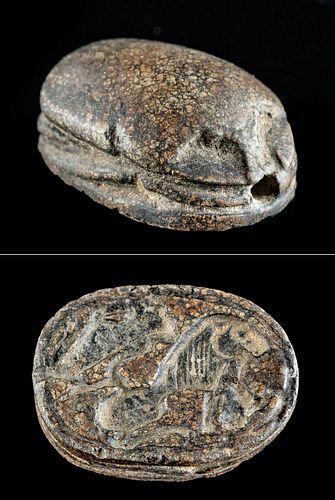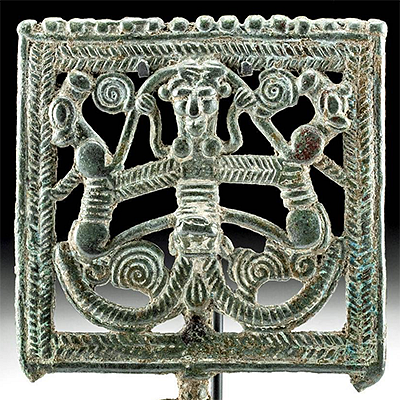Egyptian Stone Scarab Amulet with Lion, Ex Mitry
Lot 4a
About Seller
Artemis Fine Arts
686 S Taylor Ave, Ste 106
Louisville, CO 80027
United States
Selling antiquities, ancient and ethnographic art online since 1993, Artemis Gallery specializes in Classical Antiquities (Egyptian, Greek, Roman, Near Eastern), Asian, Pre-Columbian, African / Tribal / Oceanographic art. Our extensive inventory includes pottery, stone, metal, wood, glass and textil...Read more
Categories
Estimate:
$1,200 - $1,800
Absentee vs Live bid
Two ways to bid:
- Leave a max absentee bid and the platform will bid on your behalf up to your maximum bid during the live auction.
- Bid live during the auction and your bids will be submitted real-time to the auctioneer.
Bid Increments
| Price | Bid Increment |
|---|---|
| $0 | $25 |
| $300 | $50 |
| $1,000 | $100 |
| $2,000 | $250 |
| $5,000 | $500 |
| $10,000 | $1,000 |
| $20,000 | $2,500 |
| $50,000 | $5,000 |
| $100,000 | $10,000 |
| $200,000 | $20,000 |
About Auction
By Artemis Fine Arts
Nov 5, 2020
Set Reminder
2020-11-05 10:00:00
2020-11-05 10:00:00
America/New_York
Bidsquare
Bidsquare : Ancient & Ethnographic From Around the World
https://www.bidsquare.com/auctions/artemis-gallery/ancient-ethnographic-from-around-the-world-5916
Ancient art from Egypt, Greece, Italy and the Near East, as well as Asian, Pre-Columbian, Native American, African / Tribal / Oceanic, Spanish Colonial, Russian Icons, Fine art, much more! All categories, all price ranges... all legally acquired and guaranteed to be as described or your money back. Artemis Fine Arts info@artemisfinearts.com
Ancient art from Egypt, Greece, Italy and the Near East, as well as Asian, Pre-Columbian, Native American, African / Tribal / Oceanic, Spanish Colonial, Russian Icons, Fine art, much more! All categories, all price ranges... all legally acquired and guaranteed to be as described or your money back. Artemis Fine Arts info@artemisfinearts.com
- Lot Description
Ancient Egypt, New Kingdom, 18th to 20th Dynasty, ca. 1700 to 1450 BCE. A simple yet elegant hand-carved stone scarab naturally adorned in rich hues of coffee and caramel with a hole channeling lengthwise through the piece to allow it to be worn as a necklace or bracelet. The top of the ovoid scarab showcases a petite head, a bulbous wing carapace, and thinly incised grooves around the base indicative of legs. The base of the ancient amulet depicts a rightward facing seated lion, intricately carved with an impressively detailed mane, below a zoomorphic entity, possibly a bird or cobra. Boasting a smooth lustrous surface, this beautiful stone scarab is a wonderful example from ancient Egypt. Size: 0.875" L x 0.625" W (2.2 cm x 1.6 cm)
Amulets of the scarab were hugely popular for over a thousand years in ancient Egypt, a symbol with staying power similar to that of the Christian cross. Scholars posit that they were worn and carried by the living, although by the time of the Third Intermediate Period, they had also become part of the increasingly elaborate battery of items to be placed into graves for protection of the dead.
Feline and leonine images in ancient Egyptian visual culture were very popular as several deities assumed their form. This lion may represent Maahes, a solar war god commonly referred to as "The Lord of the Massacre" who took the form of a lion. Maahes was the son of Bastet, the cat goddess of Lower Egypt, but also was the son of Sekhmet, the goddess of war in Upper Egypt who also took a feline form. It is believed that his father was Ra or Ptah. Maahes was closely linked with Nefertum and was believed to be the son of both Sekhmet and Bastet. In addition, he was known as the "Avenger of Wrongs" and the "Helper of Wise Ones" and considered to be the guardian of sacred places and the protector of the innocent.
Several other Egyptian gods were depicted as a lion. These included: Apedemak - a war god from Nubia; Arensnuphis - companion to Isis also from Nubia; twin lion gods Ruty, a name that means "pair of lions"; Shesmetet, a leonine goddess with the body of a woman but the head of a lion who is regarded as an aspect of Bastet or Sekhmet, only an older deity; and Tefnut, the goddess of moisture and daughter of Ra who is depicted as a seated woman with a lion's head.
Provenance: ex-private Orange, California, USA collection, inherited by descent from Philip Mitry, noted antiquarian in Cairo prior to 1951, when he immigrated to the US
All items legal to buy/sell under U.S. Statute covering cultural patrimony Code 2600, CHAPTER 14, and are guaranteed to be as described or your money back.
A Certificate of Authenticity will accompany all winning bids.
We ship worldwide and handle all shipping in-house for your convenience.
#160152Intact and excellent with superb remaining detail and earthen deposits in recessed areas.Condition
- Shipping Info
-
All shipping is handled in-house for your convenience. Your invoice from Artemis Gallery will include shipping calculation instructions. If in doubt, please inquire BEFORE bidding for estimated shipping costs for individual items.
-
- Buyer's Premium



 EUR
EUR CAD
CAD AUD
AUD GBP
GBP MXN
MXN HKD
HKD CNY
CNY MYR
MYR SEK
SEK SGD
SGD CHF
CHF THB
THB















